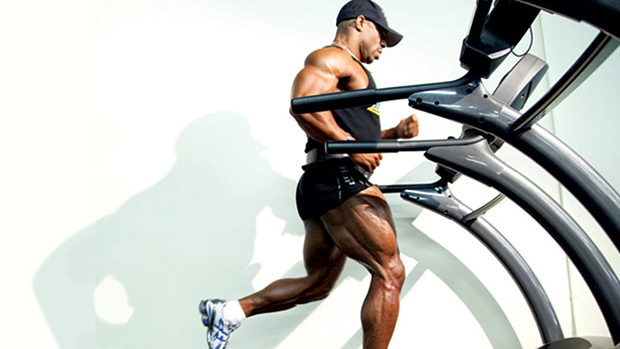This article discusses how much cardio when bulking you should be doing, if any, while trying to gain weight and build muscle mass on an increase cycle.
It is obvious that during weight loss or cutting, when the goal is to reduce the fat layer, several cardiosessions a week are simply necessary. They will help increase energy costs and cause the body to burn fat.
But what if at the moment there is a mass-gathering period, that is, an increase in muscle mass and strength? Is it necessary then to do cardio, or is it better to concentrate on hard training and eating enough food?
This topic is often discussed. In general, there is no unambiguous answer and there is no advice that would suit everyone. It is necessary to start from the type of body structure how much cardio when bulking, the amount of physical activity (without taking into account the training in the hall), appetite and how training is planned.
And yet there are several points on which it is worth dwelling in more detail. In fact, we will consider several reasons, based on which it is worth seriously considering the need for regular cardio workouts throughout the year. Further, proceeding from this, everyone can make an informed decision and make the right choice.
How to do cardio on mass storage
To begin with, we need to understand whether cardio is needed at all, if the main goal in this period is mass recruitment? Is it possible to postpone cardio for a while and at the same time successfully recruit a dry mass and a minimum of fat?
 In general, if you carefully plan a diet, you can successfully recruit a dry mass and without cardio. But, if we talk about a truly optimal option, it is better to do cardio regularly how much cardio when bulking. Here are a few reasons for this.
In general, if you carefully plan a diet, you can successfully recruit a dry mass and without cardio. But, if we talk about a truly optimal option, it is better to do cardio regularly how much cardio when bulking. Here are a few reasons for this.
Exercise of the cardiovascular system and increased endurance
Always remember the importance of training the cardiovascular system and maintaining it in a healthy state.
In the event that the usual method of training is used, implying a low or average number of repetitions and a relatively long rest between approaches, the cardiovascular system is loaded, but not trained. As a result, you can begin to experience difficulties even in order to catch up with the bus or quickly climb the stairs.
In this case, if you do not neglect cardio training, you can maintain the cardiovascular system in due order, which will positively affect all aspects of life. Moreover, this will directly affect the quality of strength training. Gradually it will be possible to increase the number of repetitions a little. The recovery between approaches will accelerate.
Next, we must take into account that if you do not do cardio on massonobore, then, psychologically, it will be very difficult to start doing a lot of cardio on cutting. In addition, long periods without endurance training lead to significant falls in this very endurance. Thus, when it comes time to remove fat, it will be difficult to withstand long cardio sessions, you will have to re-train this skill.
Proper use of energy
It is about how much cardio when bulking and for what the body will use the energy and nutrients it receives.
Training with weights in combination with cardio improves the body’s ability to use what it receives from food, to build muscle tissue and to satisfy energy needs. And we are taught not to save something in the fatty layer. Mechanisms that stimulate the use of fat to generate energy in the event of a deficiency are also being trained.
Active recovery
Low-intensity cardio improves recovery between training sessions, as it stimulates blood circulation and accelerates the delivery of nutrients to the muscles.
Minimizing the amount of fat
 Of course, attentive control over the diet is a key element in minimizing the growth of adipose tissue on massobore. But additional cardio will certainly help.
Of course, attentive control over the diet is a key element in minimizing the growth of adipose tissue on massobore. But additional cardio will certainly help.
In addition, in the case how much cardio when bulking the appetite is such that it is very difficult to restrain, an additional cardio will allow you to spend part of the energy that is being received, which will enable you to eat more.
True, it should be noted that low-intensity cardio in this case will not work, because it, on the contrary, stimulates the appetite.
On the other hand, a high intensity slightly reduces appetite, which can be convenient.
Will cardio prevent growth in muscle?
As in everything, it is important to know the measure and correctly dose everything.
Yes, too large volumes of cardio are certainly contraindicated during massaging and will lead to a slowdown in muscle growth. Only here is the threshold beyond which “too much” begins, lies much further than many think. And two or three (or even four or five) of the average duration of a cardio session per week will only benefit.
At the same time, I would like to note once again that everyone should look for a suitable option for themselves, since all people are different.
Practical tips
- As already mentioned, the amount and duration of cardio training is highly dependent on the athlete’s personal parameters. But for most people, 2-4 cardio sessions per week will be a good option. You can do 1-2 of them with a high intensity for 8-20 minutes, the rest – with a lower intensity, aerobically, for 40-60 minutes.
- It’s reasonable not to mix strength training and cardio, dividing them by the day.
- If you have a lean physique, it is logical to do less cardio, because the body is not too prone to accumulation of fat. If you, on the contrary, are inclined to completeness, then the number of cardio should be greater.
- If your work is related to physical activity, it is possible that additional cardio is not even necessary how much cardio when bulking. But if the work is sedentary, in the office, then additional physical activity is simply necessary and will only benefit.
- It is important to remember that with a large volume of strength training, one should not get involved in cardio because of the risk of getting re-ignored. Or, we must confine ourselves to aerobic cardio sessions.
Conclusions
Yes, it is worth recommending to do cardio even if the main goal is mass gain. First of all because it will improve endurance, accelerate metabolism, optimize the processing and use of nutrients, accelerate recovery and help not gain excess fat.
When planning cardio training, be sure to take into account the type of body structure, the number and volume of strength training, the overall level of your physical activity.





